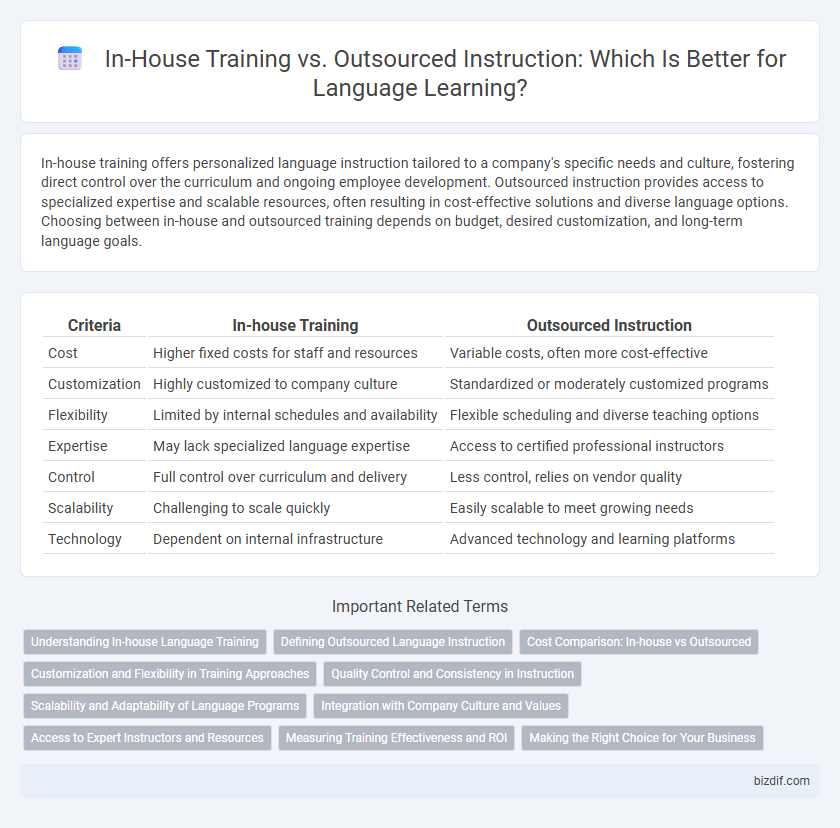In-house training offers personalized language instruction tailored to a company's specific needs and culture, fostering direct control over the curriculum and ongoing employee development. Outsourced instruction provides access to specialized expertise and scalable resources, often resulting in cost-effective solutions and diverse language options. Choosing between in-house and outsourced training depends on budget, desired customization, and long-term language goals.
Table of Comparison
| Criteria | In-house Training | Outsourced Instruction |
|---|---|---|
| Cost | Higher fixed costs for staff and resources | Variable costs, often more cost-effective |
| Customization | Highly customized to company culture | Standardized or moderately customized programs |
| Flexibility | Limited by internal schedules and availability | Flexible scheduling and diverse teaching options |
| Expertise | May lack specialized language expertise | Access to certified professional instructors |
| Control | Full control over curriculum and delivery | Less control, relies on vendor quality |
| Scalability | Challenging to scale quickly | Easily scalable to meet growing needs |
| Technology | Dependent on internal infrastructure | Advanced technology and learning platforms |
Understanding In-house Language Training
In-house language training offers tailored instruction that aligns closely with a company's specific terminology, culture, and communication goals. Employees benefit from flexible scheduling and consistent learning environments, leading to higher engagement and retention of language skills. Companies maintain greater control over curriculum development and trainer selection, ensuring that training outcomes directly support organizational objectives.
Defining Outsourced Language Instruction
Outsourced language instruction involves hiring external language experts or specialized training companies to deliver language courses tailored to an organization's specific needs. This approach provides access to diverse linguistic expertise, advanced teaching methodologies, and scalable instructional resources without the overhead of maintaining an internal training team. Organizations benefit from flexible scheduling, customized content, and up-to-date language training that aligns with industry standards and global communication requirements.
Cost Comparison: In-house vs Outsourced
In-house language training typically involves fixed costs such as instructor salaries, training materials, and administrative overhead, which can lead to higher long-term investment for companies with a smaller number of learners. Outsourced instruction often offers scalable pricing models based on the number of participants and training hours, providing more flexibility and potentially lower upfront expenses. Cost efficiency depends on factors like program size, customization needs, and frequency of training sessions, making detailed cost-benefit analysis essential for deciding between in-house and outsourced language instruction.
Customization and Flexibility in Training Approaches
In-house training offers unparalleled customization and flexibility, enabling organizations to tailor language instruction specifically to their industry jargon, corporate culture, and employee proficiency levels. Outsourced instruction, while benefiting from specialized expertise and diverse language resources, may have limited adaptability to unique internal workflows and evolving business needs. Selecting between in-house and outsourced options depends on prioritizing immediate customization and control versus access to broader pedagogical innovations and scalability.
Quality Control and Consistency in Instruction
In-house training ensures greater quality control by allowing organizations to tailor language instruction to specific company standards and culture, providing consistency across all learners. Outsourced instruction may vary in quality depending on the provider's expertise and less direct oversight, potentially leading to inconsistent learner outcomes. Maintaining consistent instructional methods and materials in-house supports better alignment with organizational goals and employee skill development.
Scalability and Adaptability of Language Programs
In-house training offers tailored language programs that align closely with company culture but may face challenges in scalability due to limited internal resources. Outsourced instruction provides scalable solutions with access to diverse expertise and advanced technology, enhancing adaptability to various learning needs and evolving market demands. Companies often balance both approaches to optimize flexibility and growth in language proficiency initiatives.
Integration with Company Culture and Values
In-house training ensures seamless integration with company culture and values by tailoring language instruction to reflect specific organizational norms and communication styles. Outsourced instruction may lack this customization, potentially resulting in a disconnect between language skills taught and the company's unique cultural context. Effective language programs align training content with internal values to foster consistent communication and reinforce corporate identity.
Access to Expert Instructors and Resources
In-house training offers direct access to internal experts deeply familiar with company goals and culture, ensuring tailored instruction aligned with specific language needs. Outsourced instruction provides a broader selection of specialized language professionals and advanced learning resources that may not be available internally. Companies prioritize access to expert instructors and comprehensive materials when choosing between scalable outsourced programs or customized in-house language training solutions.
Measuring Training Effectiveness and ROI
Measuring training effectiveness in in-house language instruction involves direct observation, employee feedback, and performance assessments tailored to company-specific goals, which ensures alignment with organizational needs. Outsourced instruction often uses standardized evaluation tools and post-training tests, providing quantifiable data on learner progress and ROI across diverse industries. Comparing ROI requires analyzing cost-efficiency, knowledge retention rates, and improvement in workplace communication, with in-house training offering customization benefits while outsourced programs provide scalability and expert content delivery.
Making the Right Choice for Your Business
Choosing between in-house training and outsourced instruction depends on factors such as budget, expertise, and customization needs. In-house training offers tailored programs aligned with company culture but may require significant resource investment, while outsourced instruction provides access to specialized skills and scalable solutions at potentially lower costs. Evaluating your business goals, employee learning preferences, and long-term training strategy ensures the selection of the most effective language instruction method.
In-house Training vs Outsourced Instruction Infographic

 bizdif.com
bizdif.com